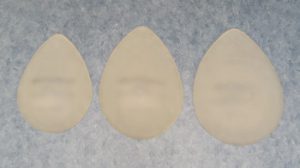 One of the most important decisions when getting a breast augmentation is choosing the size of the implant. When choosing a breast implant size it is important to choose an implant large enough to make the procedure worthwhile. It is also important to choose a breast implant size that is not so grossly out of proportion that it will cause physical problems (shoulder and neck pain), breast problems (displacement, premature sagging, breast tissue thinning), activity problems (cannot exercise because implants are too large), and look abnormal. Patients frequently get advice from friends about the size of breast implants to choose, but the final decision should be made after the informed consent procedure (see section on “sizers” below) and without any preconceived notions. Because body shape and size varies widely from patient to patient, the most appropriate size of the breast implants to achieve proportion will also vary widely. Most patients seeking breast augmentation desire an implant size that will make them appear more in proportion, and not an implant size (too large, out of proportion) that gives the “operated look” (implant too large for an individuals habitus). The size of the breast implants that will create an “in proportion look” will vary based on many factors including height, weight, shoulder width, amount of breast skin available, state of symmetry (breasts match) or asymmetry, and the age of the patient. Another important factor is the anticipated or typical activity level of the patient. Patients that are extremely active may choose a breast implant size that is not excessively large which can inhibit activity or exercise. For example, if a patient enjoys jogging on a regular basis an extremely large implant would not be the best choice for obvious reasons.
One of the most important decisions when getting a breast augmentation is choosing the size of the implant. When choosing a breast implant size it is important to choose an implant large enough to make the procedure worthwhile. It is also important to choose a breast implant size that is not so grossly out of proportion that it will cause physical problems (shoulder and neck pain), breast problems (displacement, premature sagging, breast tissue thinning), activity problems (cannot exercise because implants are too large), and look abnormal. Patients frequently get advice from friends about the size of breast implants to choose, but the final decision should be made after the informed consent procedure (see section on “sizers” below) and without any preconceived notions. Because body shape and size varies widely from patient to patient, the most appropriate size of the breast implants to achieve proportion will also vary widely. Most patients seeking breast augmentation desire an implant size that will make them appear more in proportion, and not an implant size (too large, out of proportion) that gives the “operated look” (implant too large for an individuals habitus). The size of the breast implants that will create an “in proportion look” will vary based on many factors including height, weight, shoulder width, amount of breast skin available, state of symmetry (breasts match) or asymmetry, and the age of the patient. Another important factor is the anticipated or typical activity level of the patient. Patients that are extremely active may choose a breast implant size that is not excessively large which can inhibit activity or exercise. For example, if a patient enjoys jogging on a regular basis an extremely large implant would not be the best choice for obvious reasons.
 When discussing breast implant size the topic of “cup size” is discussed. It is very difficult to discuss implant size relative to bra size because there is no standardization of bra cup size in the bra manufacturing industry. This means that a “C cup” size bra manufactured in Korea might not be the same size as a “C cup” sized bra manufactured in Italy. As a result, breast implant size can be discussed only in very general terms. For example, a patient may indicate that they would rather be in the “C cup” range as opposed to the “D cup” range, or vice versa. The breast implant size is more accurately discussed in terms of ccs (cubic centimeters). Like bra sizes, there is not a tight relationship between breast implant ccs (cubic centimeters) and “cup size”. However, some general estimations can be made. As a general rule, between 100 ccs and 150 ccs will approximate one cup size in most brands of bras. The number of ccs per “cup size” varies due to the absence of manufacturing standards and the size (back size) of the bra. To further confuse the matters, as back size changes, so does the “cup size”, even with bras made by the same manufacturer. For example, if one compares a “32 D cup” bra to a “42 C cup” bra made by the same manufacturer, the “C cup” may be larger than the “D cup” which is counterintuitive. There can be regional differences in standard “cup size” for bra manufacturers. One might expect bras manufactured in Korea to be different in “cup size” compared to “cup size” made in Italy. In addition, bra “cup sizes” can vary in one country based on the retailer’s manufacturing source. The same holds true for bathing suits. As a result, bras sold by Victoria’s Secret® may be sized differently than bras sold by Belks®. Beyond a very general concept of what general size is desired, using “cup size” as a single determinant for choosing implant size is not very useful.
When discussing breast implant size the topic of “cup size” is discussed. It is very difficult to discuss implant size relative to bra size because there is no standardization of bra cup size in the bra manufacturing industry. This means that a “C cup” size bra manufactured in Korea might not be the same size as a “C cup” sized bra manufactured in Italy. As a result, breast implant size can be discussed only in very general terms. For example, a patient may indicate that they would rather be in the “C cup” range as opposed to the “D cup” range, or vice versa. The breast implant size is more accurately discussed in terms of ccs (cubic centimeters). Like bra sizes, there is not a tight relationship between breast implant ccs (cubic centimeters) and “cup size”. However, some general estimations can be made. As a general rule, between 100 ccs and 150 ccs will approximate one cup size in most brands of bras. The number of ccs per “cup size” varies due to the absence of manufacturing standards and the size (back size) of the bra. To further confuse the matters, as back size changes, so does the “cup size”, even with bras made by the same manufacturer. For example, if one compares a “32 D cup” bra to a “42 C cup” bra made by the same manufacturer, the “C cup” may be larger than the “D cup” which is counterintuitive. There can be regional differences in standard “cup size” for bra manufacturers. One might expect bras manufactured in Korea to be different in “cup size” compared to “cup size” made in Italy. In addition, bra “cup sizes” can vary in one country based on the retailer’s manufacturing source. The same holds true for bathing suits. As a result, bras sold by Victoria’s Secret® may be sized differently than bras sold by Belks®. Beyond a very general concept of what general size is desired, using “cup size” as a single determinant for choosing implant size is not very useful.
During the consultation the goal of the breast augmentation surgeon is to attempt determination of an objective number (breast implant size in ccs) from a subjective communication (I want to be a “C cup”). One very accurate method for determining the patients’s desired breast implant size is to use breast “sizers”. Breast “sizers” are implants (samples for “try in” only) that can be placed in the bra (sports bras work best) to accurately estimate the desired breast volume. The “sizers” are available in gradated sizes from very small to very large and come in round and anatomic (breast shaped) shapes. Choosing a breast implant size is not something that patients do on a regular basis. Helping patients choose a breast implant size is something that Plastic surgeons do on a regular basis and can therefore make suggestions based on training and experience. The first step in the process is a discussion with the patient about her specific goals. By defining the patient’s goals and other parameters (anticipated activity level), the Plastic surgeon can get a general idea about the breast size desired. The second step is to determine what general “cup size” would be ideal keeping in mind that this is a very vague subjective concept, as previously described. With this information the Plastic surgeon then has a general idea of a starting point for a recommendation of a breast implant size. A recommendation can then be made for a specific breast implant size in ccs using the implant “sizer”. The patient can then try the “sizer” in her bra to get a better idea of what size implant is desired. The patient can then choose a larger or smaller breast implant to reach the desired result. There are many gradated “sizers” available but it is important to remember that saline implants are completely adjustable at the time of surgery, so if a size is desired that is “in between sizers”, this can be achieved. It is important that the breast implant base diameter is correct (matches the breast size), and this size varies from patient to patient. While two dimensional computer imaging tools can be used to “pin” a breast size on an image of the patient, a three dimensional approach (breast implants placed into the patients bra) is preferred by many Plastic surgeons. The process of choosing a breast implant size does not have to be completed at one appointment. If a family member or spouse wishes to opine on the breast implant size that is requested this is welcomed as long as the patient invites those opinions.
